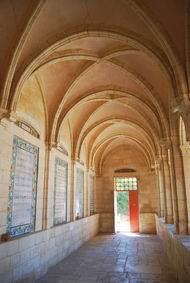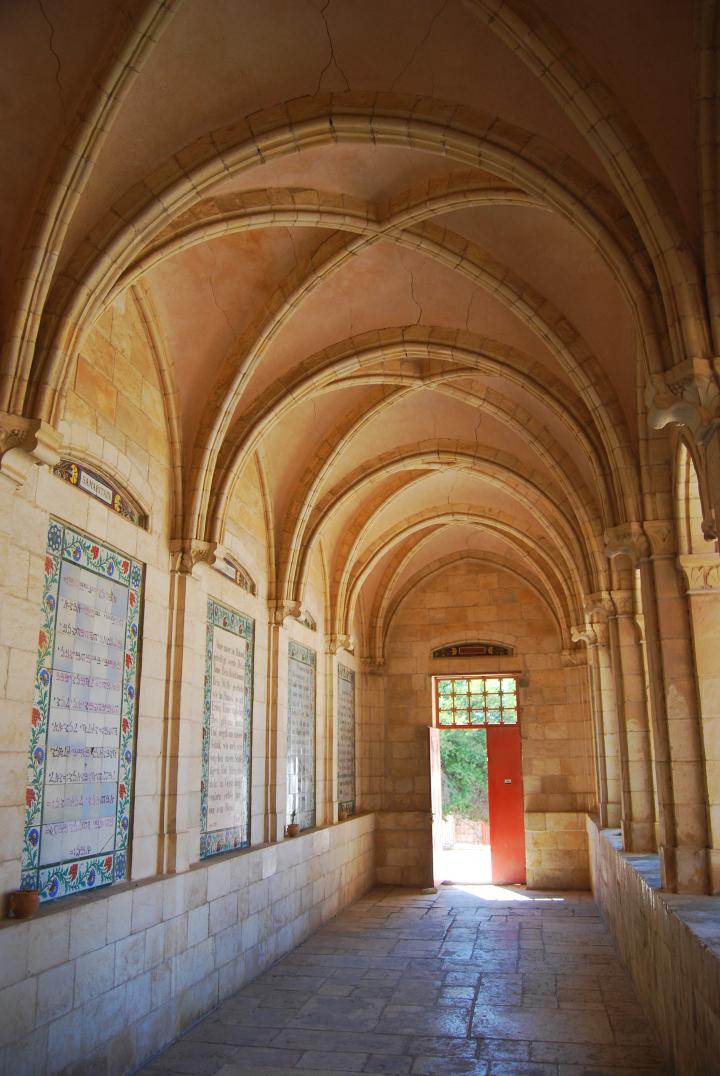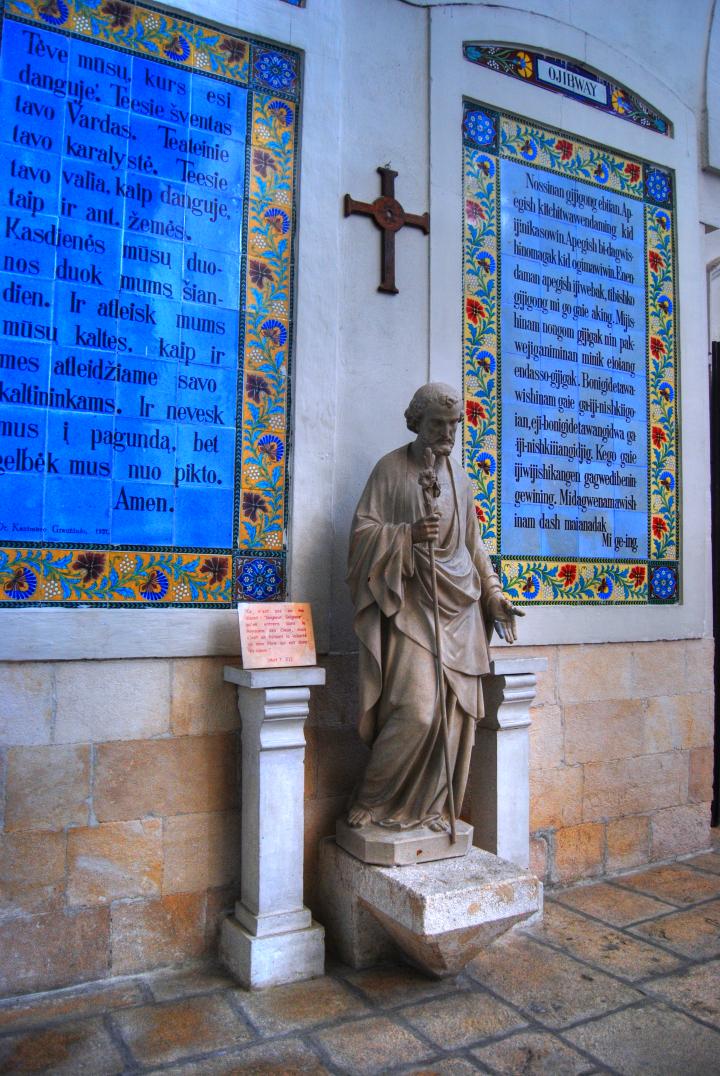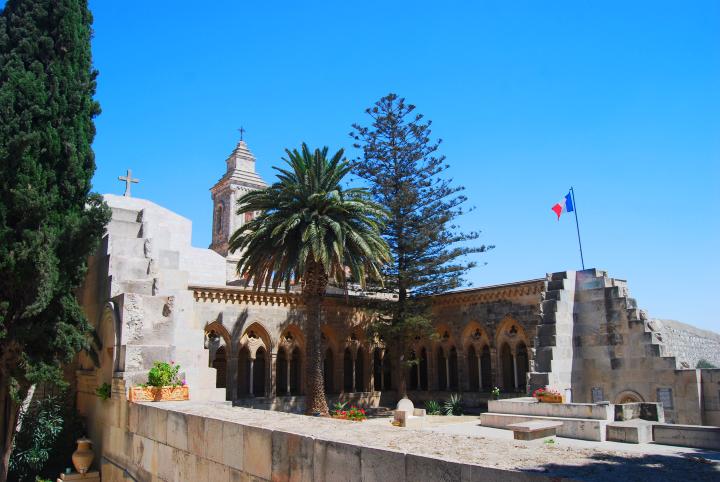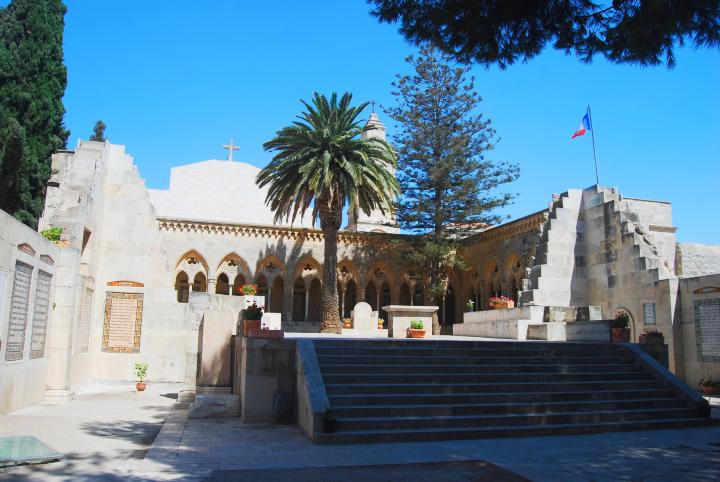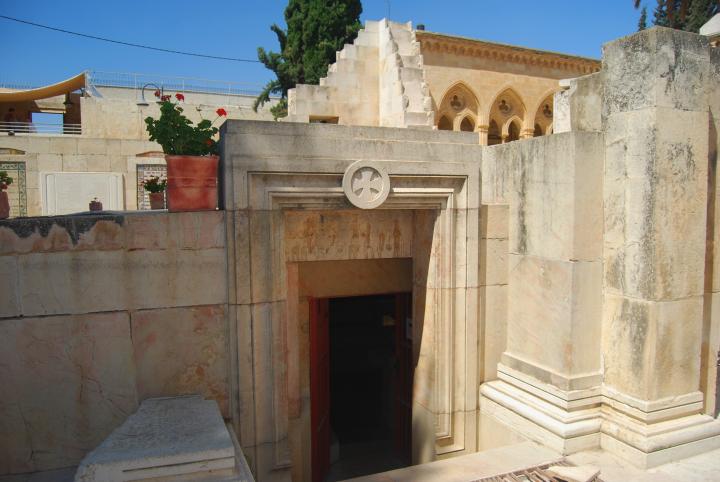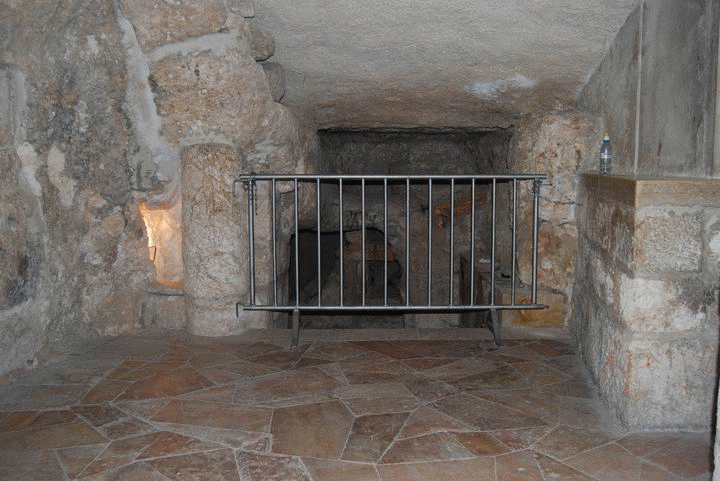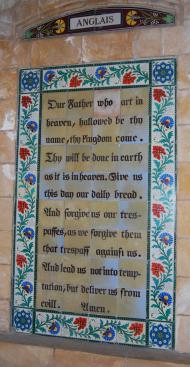The convent is located at the site of the ruins of the Byzantine Eleona Basilica, which was built over a cave where according to tradition was the place where Jesus hid with his disciples and taught the “Our Father” (Pater Noster) prayer.
Home > Sites > Jerusalem > Mt. Olives > Pater Noster (Carmelite) convent
Contents:
Overview
Location
History
Photos
* Entrance
* Interior
* Court yard
* Cave/Crypt
Biblical
Etymology
Links
Overview:
The convent, controlled by the Carmelite Cloistered Sisters, is located at the site of the ruins of the “Eleona” Basilica, built in the 4th century by Constantine. The Byzantine church was built over a cave where according to tradition was the place where Jesus hid with his disciples and taught the “Our Father” (Pater Noster) prayer, one of the most important prayers in Christianity. The Crusaders rebuilt part of the church, and a new convent was built in the 19th century.
Luke 11: 2: “And he said unto them, When ye pray, say, Our Father which art in heaven, Hallowed be thy name”.
Location:
An aerial view is seen below showing the location of the church (right off the center of the map) and other points of interest (such as the adjacent Ascension chapel, another traditional site).

History of the place:
-
Byzantine period – Basilica of Eleona
In the 4th century a church was commissioned and built by Constantine, in a site marked by Helena, mother of Constantine. It was one of the four churches constructed by the first Christian Roman emperor in the Holy Land. It was built at the site of Ascension, and was called the Basilica of Eleona (Mt Olives in Greek).
The magnificent structure was built in 3 levels on the slopes of Mount of Olives, with stairs connecting each level (Church, Atrium and the outside). The church was built on the highest level as a 30M x 18.6M basilica (a long rectangular hall with two rows of columns). Its apse was on the east side, facing the rising sun. The center level was an atrium, a colonnaded forecourt, about 25M long. The lowest level was in the west side – a portico (porch) based on 6 columns. Only its foundations were found during the excavations in the 19th century, including the crypt (cave) which was located under the eastern edge of the church.
-
Persian and Arab period – destruction
The church was destroyed by the Persians in May 614, after 21 days of siege on Jerusalem. Most of the Christian churches in Jerusalem were leveled; tens of thousands Christians butchered in the city, and more than a thousand Christians were butchered on Mount of Olives . In 638 the Arabs replaced the Persians as conquerors but the Church remained in ruins.
Some of the Byzantine remains can be seen in the back yard outside of the present court yard. In 1868, during the construction works, a 5th century mosaic floor of the Eleona Church was unearthed. The mosaic floor contained two Greek inscriptions: Psalms 121:8: “The LORD shall preserve thy going out and thy coming in” and Psalms 118:20: “This gate of the LORD, into which the righteous shall enter.”.
-
Crusaders period – Pater Noster
The Crusaders took the city in 1099 and reconstructed parts of the ruins. In 1152 a new small church was rebuilt by the Danish brothers from Jutland – Bishop Svein and Admiral Eskill Sveinsson. They were buried in the church and their tomb stones were recovered in 1869, and were embedded into the modern church.
The Crusaders church was renamed “Pater Noster”, marking the site where Jesus taught his disciples the prayer. The Ascension site was relocated to the adjacent chapel, the Ascension chapel.
-
Arab and Mamlukes period – In Ruins
The Crusaders church was damaged after the Crusader defeat to Saladin forces in 1187. It was totally leveled in 1345 by the Mamlukes, who replaced the Arabs as rulers in Jerusalem during the years 1267-1480.
-
Late Ottoman period – Rebuild
After more than 500 years later the Christian and Jewish population was allowed to build new structures, and the city expanded outside the Ottoman walls. A Carmelite convent was established in 1872 in the land purchased earlier by the French Bossi Aurelia, Princess de la Tour d’Auvergne. The tomb of the princess (died 1889) is located here in a marble sarcophagus.
In 1874 the present church was built on the north side of the ruined church. A large monastery was also built adjacent to the church and grotto. In 1873 the church and convent were transferred to the management of the Catholic Carmelite Cloistered Sisters.
-
British Mandate – unfinished church
In 1920 a new church of the Sacred Heart was constructed over the Grotto, but its construction was stopped and only the base of the building and parts of its walls were completed.
-
Modern times
The convent, church and cave is open to the public. It is a recommended place to visit, and located near two other Christian sites – Ascension chapel and the Russian Ascension convent. The highlights of the site is the cave where Jesus taught his disciples on his last journey, and a large collection of ceramic tiles that are displayed on its walls, bearing the Luke 11:2-4 Pater Noster prayer written in over 70 languages.
Photos:
(a) Entrance and Halls
The inner entrance to the convent is seen after entering the gate.
Click on the photos to view in higher resolution…
The portico hallway on the eastern side is seen below, with four of the ceramic tiles with the Pater Noster prayer inscription written in various languages.
The south hall, behind the church, is of similar design.
(b) Church interior
A view of the interior of the church is seen below.
Along the walls are ceramic tiles with the Luke 11:2-4 prayer verse.
(c) Court Yard
A view of the back yard of the convent is seen below. The flag indicates the French connection. This was the site of the Byzantine church.
A section of the unfinished church is seen below (1920, The Sacred Heart church). On its walls are some of the 70+ ceramic tiles with the prayer passage of Luke 11, each written in a different language.
The stairs lead up to an unfinished church that started construction in 1920. It is located above the cave where according to tradition was where Jesus hid and taught the prayer.
(d) The cave
The entrance to the cave on the eastern side is seen below, which was part of the 1920 unfinished church. The cave was the crypt of the Byzantine church (“Basilica Eleona”), which was one of the four churches that Constantine established in the 4th century.
The photo below shows a view of the cave, which partially collapsed.
A small praying corner is located on the north side of the cave. It was reconstructed inside the cave in 1927.
Within the cracks of the stones are dozens of notes written by the visitors.
Another (animated) view of the Grotto is seen below.
The western entrance to the cave is seen in the photo below.
Biblical:
(a) Luke 11 1-4
Luke’s version of the prayer was conducted on the slopes of Mount of Olives, where the convent is located:
“And it came to pass, that, as he was praying in a certain place, when he ceased, one of his disciples said unto him, Lord, teach us to pray, as John also taught his disciples. And he said unto them, When ye pray, say,
Our Father which art in heaven, Hallowed be thy name. Thy kingdom come. Thy will be done, as in heaven, so in earth. Give us day by day our daily bread. And forgive us our sins; for we also forgive every one that is indebted to us. And lead us not into temptation; but deliver us from evil”.
One of the 70+ prayer ceramic tiles within the convent, with Luke 11:2-4 text
(b) Matthew 6 9-13
The Matthew version of the Pater Noster prayer is part of the sermon on the mount, which is in the Galilee (see mount of Beatitudes).
“After this manner therefore pray ye: Our Father which art in heaven, Hallowed be thy name. Thy kingdom come, Thy will be done in earth, as it is in heaven. Give us this day our daily bread. And forgive us our debts, as we forgive our debtors. And lead us not into temptation, but deliver us from evil: For thine is the kingdom, and the power, and the glory, for ever. Amen”.
(c) Luke 21 37
Luke identifies the place where Jesus stayed at night as Mount of Olives.
“And in the day time he was teaching in the temple; and at night he went out, and abode in the mount that is called the mount of Olives.”
Etymology (behind the name):
-
Pater Noster – Latin: “Our father” meaning “Our Lord”; according to tradition, this prayer was taught by Jesus at this site
-
Eleona – the Greek name of Mount of Olives; Elaion means “olive grove”.
Links:
- Prayer Tiles collection of 140 languages
- Archaeological summary – Municipality of Jerusalem survey (Hebrew)
- Who’s who in Holy Land (Sveinsson brothers)
- Ancient Churches in the Holy Land – Yoram Tsafrir [Bib Arch, 1993]
BibleWalks.com – making the Bible alive
Russian Ascension<—previous site–<<< All Sites >>>—next Jerusalem site–> Yad Avshalom
This page was last updated on Jan 20, 2010
Sponsored links:
